Late winter viewing, part two
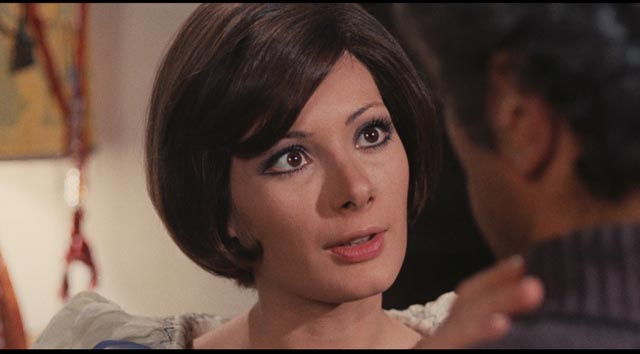
Your Vice Is a Locked Room and Only I Have the Key (1972)
My most recent foray out to a theatre was to catch the new Coen Brothers movie, Hail, Caesar! Although the Coens have made several of my favourite movies, I find them pretty hit-or-miss – in fact, they’ve made some of my least favourite movies as their tendency to treat characters with snarky condescension really rubs me the wrong way.
Although not quite up there with their best work (Miller’s Crossing, The Big Lebowski, The Man Who Wasn’t There, True Grit, Inside Llewyn Davis), Hail, Caesar! is one of their most entertaining films, with engaging characters and witty dialogue. I’m still mulling over the apparent regressive attitudes indicated by their conflation of writers, intellectuals, homosexuals and communist subversion, but even though the film ultimately seems to reassert the false Hollywood self-image that “it’s just entertainment” without any sociological or political content, I really enjoyed the film. The various genre pastiches are genuinely funny and the cast is uniformly terrific (I particularly enjoyed Frances McDormand’s tough, old-school film editor).
*
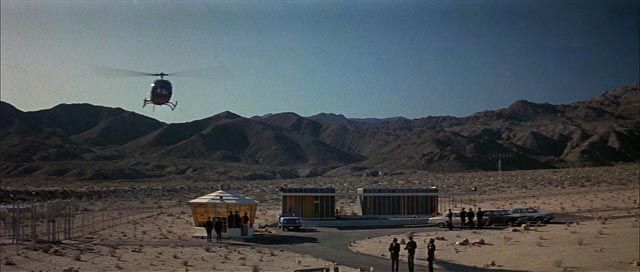
The Satan Bug (John Sturges, 1965)
A while back, I wrote a not terribly favourable review of John Sturges’ The Satan Bug (1965). That was for a rather weak MGM burn-on-demand disk. Kino’s recent Blu-ray offers a much stronger visual presentation, but the movie remains pretty dull for an apocalyptic thriller. The twin problems are a lazy script by James Clavell and Edward Anhalt, which doesn’t make any effort to provide the characters with strong or plausible motivations, and Sturges’ plodding direction. The best element remains the glimpses of the effects of the released virus on the Florida keys as observed from a low-flying helicopter.
The chief reason for getting this upgrade was a commentary track by the DVD Savant himself, Glenn Erickson. Like me, he has an innate enthusiasm for the genre and he supplements his information about the production with observations about the sub-genre of bio-terror science fiction. While he goes as far back as the Boulting Brothers’ nuclear-threat thriller Seven Days to Noon (1950), and provides a fairly comprehensive list, I did notice the absence of any reference to George C. Scott’s Rage (1972), which is almost as plodding as The Satan Bug, but manages to muster a sombre intensity lacking in Sturges’ work.
*
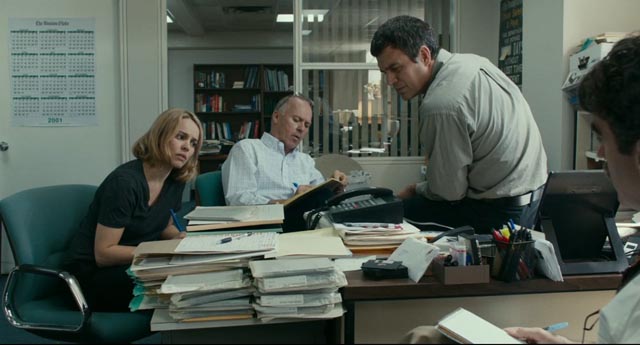
Spotlight (Tom McCarthy, 2015)
I finally got around to watching Tom McCarthy’s fact-based newspaper procedural just a few days before it won this year’s Best Picture Oscar. I have to say that I was somewhat underwhelmed. This may be in part because the core story is now so familiar that the film is completely devoid of any sense of revelation. But it’s also due to the rather flat, unimaginative direction which gives it the air of an old-style made-for-TV movie.
The one big asset is the cast, which is excellent, a strong ensemble devoid of star turns, giving equal emphasis to the major characters and the smallest supporting roles. While there’s much to appreciate in these performances, the overall impression given by the film is of a dutiful recounting of an important story which keeps its focus fairly tightly on the immediate actions of these characters while merely suggesting the much larger issues which even fifteen years later still remain unresolved.
*
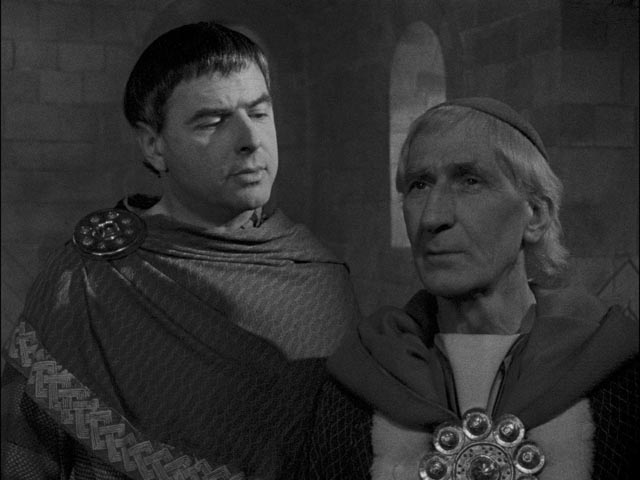
Murder In the Cathedral (George Hoellering, 1951)
This adaptation of T.S. Elliot’s verse play about the murder of Thomas Beckett in 1170 was the only dramatic feature directed by Hungarian distributor and motion picture exhibitor George Hoellering (he also directed one documentary feature and several shorter films). The film, which won an award for production design at the Venice Film Festival in 1951, where Hoellering was also nominated for the Golden Lion, is a fascinating piece of work. Stylistically, it harkens back to the silent era, with visuals strongly reminiscent of Dreyer’s Passion of Joan of Arc. The film’s (and Elliot’s) argument is that in the conflict between Beckett’s spiritual view of the world and Henry II’s temporal, political view lie the roots of modern secular society. That, in a sense, Beckett’s sacrifice was necessary to lay the foundations of the modern world.
As a visual evocation of the medieval world, Murder In the Cathedral makes an interesting companion for Orson Welles’ masterpiece Chimes At Midnight, although Hoellering’s approach is more spartan than Welles’. The film’s mix of amateur and professional actors is well-handled by Hoellering, with an actual priest, Father John Groser, dominating the production with an authoritative performance as Beckett.
The BFI’s dual-format edition offers two versions of the film, a 114-minute theatrical release cut and the longer, 139-minute “festival cut” which won the award at Venice. The latter seems preferable as it allows for a more nuanced unfolding of the story with some evocative visual moments which have been trimmed from the later version. There are also three of Hoellering’s documentary shorts: Message From Canterbury (1944), with the then Archbishop delivering a sermon towards the end of the war; Shapes and Forms (1950), an almost abstract treatment of an exhibition of art displaying correspondences between the modern and the “primitive”; and Glasgow Orpheus Choir (1951), celebrating the final concert of the choir under the direction of its retiring conductor.
*
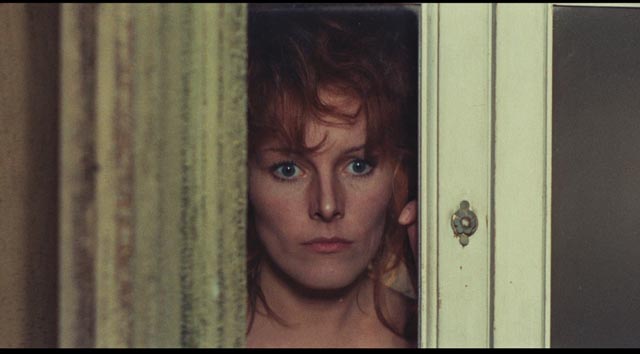
Edgar Allan Poe’s Black Cats
(Sergio Martino/Lucio Fulci, 1972/1981)
This limited edition (3000 copies) box set from Arrow seems to stretch the limits of thematic packaging, with an almost arbitrary linking of two Italian horror/giallo titles which claim Poe’s short story “The Black Cat” as their “inspiration”. Apart from the presence of a cat in each film, there’s really no other link between them.
Sergio Martino’s Your Vice Is a Locked Room and Only I Have the Key (1972), if nothing else, possesses one of the greatest of all giallo titles. Co-scripted by the prolific Ernesto Gastaldi, the film features Luigi Pastilli as the sadistic writer Oliviero, a man whose writer’s block and fixation on his dead mother signal an impotence which spurs him to torment his wife Irina (Anita Strindberg) in front of the servants and groups of hedonistic “hippies” who regularly turn up at the villa for wild parties. Things get complicated when his niece Floriana (Edwige Fenech) turns up and proceeds to seduce both him and Irina. Meanwhile, his dead mother’s black cat Satan seems to be driving Irina nuts, attacking her doves and springing out of dark corners.
When several local women are brutally murdered, suspicion falls on Oliviero. In Gastaldi’s elaborately structured script, this giallo element turns out to be something of a red herring, a narrative diversion to distract from the psycho-sexual complications at the villa. The Poe element eventually turns up as bodies are sealed behind a cellar wall and the cat’s cries lead the police to find them.
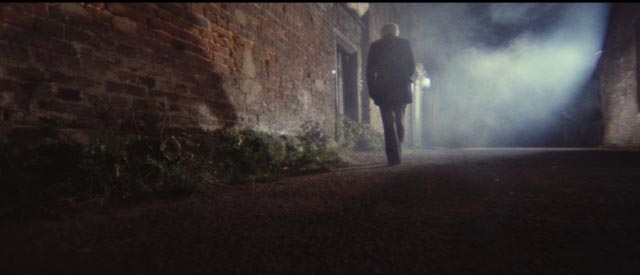
Lucio Fulci’s The Black Cat (1981) came in the midst of his string of famous horror successes, between City of the Living Dead and The Beyond, yet failed to gain much traction with his burgeoning fan base. Unlike those better know films, it avoids piling on big gore effects and aims for something more low-key and atmospheric. But it nonetheless has some interest because of its atypical setting – a small English village – and the presence of the inimitable Patrick Magee as Professor Robert Miles in his second-last feature (he appeared later the same year in Walerian Borowczyk’s The Strange Case of Dr. Jekyll and Miss Osbourne, released just a couple of months later).
Despite a weak script which never manages to pull its elements together coherently, The Black Cat does have plenty of atmosphere and some effective set-pieces. The most interesting elements of the story, revolving around Professor Miles’ attempts to communicate with the dead by making late night audio recordings in graveyards and his apparent psychic connection with a black cat, remain undeveloped while the narrative follows the investigation of Scotland Yard’s Inspector Gorley (David Warbeck) into a series of mysterious deaths in the village. Gorley enlists the help of visiting American photographer Jill Trevers (Mimsy Farmer), and both of them find themselves targeted by the vicious cat, with Jill naturally ending up behind that cellar wall.
If the script by Fulci and Biagio Proietti had been better written, The Black Cat might have been on a par with The Beyond, but as it is it remains an interesting misfire among Fulci’s distinctively idiosyncratic horrors.
Arrow’s dual-format set presents both films in restored versions scanned from the original negatives, and they’re supplemented with substantial special features, including a commentary on The Black Cat by Fangoria editor Chris Alexander. Stephen Thrower offers an analysis of The Black Cat and a tour of the village where it was shot; and there are interviews with co-star Dagmar Lassander and David Warbeck. For Your Vice, there’s a lengthy interview with Martino, a making-of featuring Martino, Edwige Fenech and Gastaldi; a visual essay by Michael Mackenzie about Martino’s gialli; an appreciation of Fenech by film historian Justin Harries; and a brief chat by Eli Roth about the film and its director. And as is typical with Arrow’s special editions, there’s a nicely produced book, an 80-page softcover containing lots of photos, several essays on the films, Poe’s original short story, and Lucio Fulci’s final interview, given just a few months before his death in 1996.
*
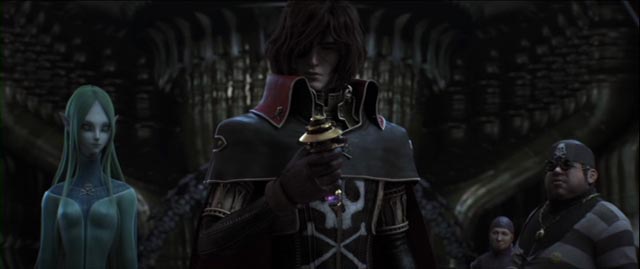
New from Twilight Time
Finally, two recent disks from Twilight Time. Both are Japanese, but they couldn’t be farther apart in conception and execution.
Shinji Aramaki’s Harlock: Space Pirate (or as it says on-screen Space Pirate Captain Harlock, 2013) is a 3D CGI animated feature from Toei based on a manga and anime series dating back almost forty years. I wasn’t familiar with any of its previous incarnations, so can only judge the feature on its own terms. In this light, it’s both impressive and a disappointment. While the visuals are eye-popping, the script is murky and confusing. I got the impression that the writers were struggling to cram in as much of the property’s lengthy history as they could in less than two hours, all the while assuming that an audience would be familiar enough to fill in missing details.
The story follows Logan, a young man who manages to get aboard Harlock’s massive ship, apparently with ulterior motives. Harlock, complete with scar and eyepatch, is a renegade on a mission which violates the regulations of the Gaia Commission which rules human-inhabited space. While evading pursuit, the “pirates” are planting explosive devices at various nodal points throughout the galaxy. It eventually emerges that these are intended to “reset” the universe to undo all the damage humans have unleashed through their wars and colonization. There are various hints about the identities of the characters and their relationships, many of which remain unresolved as the film focuses all its attention on all that spectacular imagery.
This two-disk set seems a bit anomalous for Twilight Time (their only previous animated release was Jimmy Murakami’s artful When the Wind Blows). They present the film on two disks, one with the original Japanese cut, the other with the slightly shorter international version, both in 3D and 2D (I watched it flat). The extras are a collection of brief featurettes and interviews all cut in a rushed, irritating style as if intended merely as promotional advertising aimed at kids with short attention spans.

No doubt it’s a sign of my age, but I got far more satisfaction from The Little House (2014), an exquisite family drama by the remarkable Yoji Yamada, probably best known now for The Twilight Samurai trilogy (2002-06). He co-wrote and directed The Little House at age 83 (and has made two more features since).
Flashing back from the funeral of an elderly woman named Taki, the film gradually uncovers layers of personal and national history going back to the ’30s when the young Taki leaves a small northern village to take work as a servant in a middle class household in Tokyo. Keeping the focus close to home, Yamada finds depths of emotion in Taki’s relationship with her employer’s wife Tokiko as she witnesses a tentative romance between Tokiko and Itakura, a young worker from her husband’s office. As in much of Yamada’s work, rich currents of emotion run beneath a calm surface, expressed in the smallest of details and completely without melodramatic flourishes.
There are no extras on the disk other than an isolated score track and a trailer, but in this case the film itself is more than enough to satisfy.
*
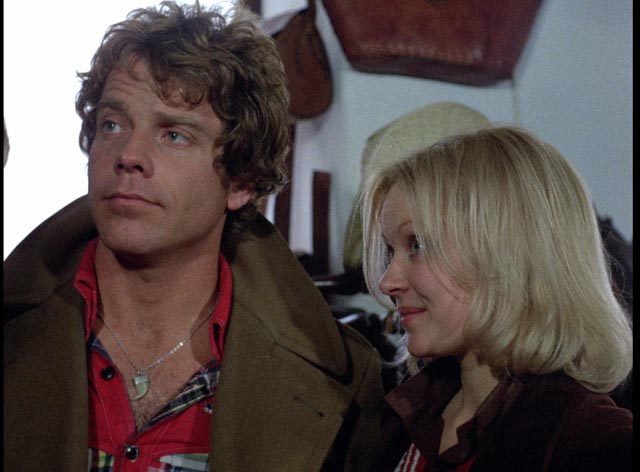
Island of Death (Nico Mastorakis, 1976)
A couple of perverted and maniac killers get loose on a Greek island. – IMDb synopsis
I actually watched Nico Mastorakis’ Island of Death (1976) quite a while back, but didn’t mention it before because, frankly, I wasn’t sure what to say about it. Written and directed by a Greek filmmaker in a deliberate attempt to cash in on the commercial success of low budget exploitation movies which were breaking previous taboos about on screen sex and violence at the time, it was shot on location in Mykonos, taking advantage of the gorgeous scenery to boost production values. Reputedly written in two days, it has an odd thrown-together feel (intensified by the wildly uneven acting of a cast which seems largely amateur) which occasionally approaches hallucinatory heights.
A young vacationing couple arrive on the island and proceed to amuse themselves by brutally killing anyone they deem sinful. The movie plays from their point of view, inviting the audience to side with them even as it progressively reveals more and more sordid details about their lives and perversions. In the hands of a more skillful director, it might have attained a level of savage black comedy, but Mastorakis directs everything blandly, with little stylistic inflection. It’s possible to read this approach in two ways, depending on the viewer’s mood: either as a straight-faced comedic comment on the characters’ narcissistic self-righteousness, or as the director’s inability to come to terms with the amoral violence they perpetrate.
I had initially expected something like Narciso Ibanez Serrador’s Who Can Kill a Child?, made the same year in Spain, but Mastorakis has little of Serrador’s cinematic skill and none of his seriousness of purpose. Despite ending up on the British “video nasties” list, Island of Death has strangely little impact, its transgressions failing to produce any genuine horror or disturbance.
But I thought I’d mention it now because I just passed it along to my friend Steve, one-time writer of paperback horror novels, now a computer whiz: the very brief review he emailed me made me laugh out loud:
“Just watched Island of Death last night. Reminded me of Shirley Valentine. And, strangely, Sisterhood of the Traveling Pants, with which it shares a colour palette.
“Of course, there was more murder, bestiality, golden showers, incest, rape and nudity in this one.
“Had never seen it before. Guess it never showed up here in the 70s, or was banned.”
This oddity was given a Blu-ray release last year by Arrow, with a bright and colourful full-frame 2K transfer and a big bunch of extras, including an almost-40-minute introduction by Stephen Thrower, an archival interview with Mastorakis, a tour of the film’s locations with the director, more than half an hour’s worth of trailers for many of his movies, plus a four-part survey of his entire career which runs more than two-and-a-half hours. Is Island of Death worth this kind of lavish attention? The answer to that will definitely depend on the individual viewer’s taste … and mood.
Comments